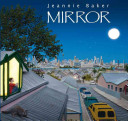
In Sydney, Australia, and in Morocco, two boys and their families have a day of shopping. Readers are invited to compare illustrations in two wordless stories that are intended to be read one from left to right and the other from right to left.
See the review at WOW Review, Volume 3, Issue 2
- ISBN: 9780763648480
- Author: Baker, Jeannie
- Published: 2010 , Candlewick Press
- Themes: Culture, diversity, Family, Identity, Love, Markets, relationship
- Descriptors: Australia, Bilingual, Early Years (ages 2-6), Oceania, Picture Book, Primary (ages 6-9), Realistic Fiction, Visual Narratives
- No. of pages: 40

Seemi
This is one of those brilliant picture books that are carried by the ingenious collage images by the author/illustrator. The issue within this wordless picture book is the dominant us/other binary brought out through the visual comparison/representation of urban Sydney Australia and rural Morocco. The universality of the characters’ lived experiences highlight the differences rather than the similarities. The book also reinforces consumerism where Morocco/Muslim World has a need of technology and the Western nations that of handmade carpets; the name of the shop that sells these carpets in Sydney is “magic carpets” that reinforces the stereotypical images of the rural backdrop of Aladdin/ Scheherazade and it also manages to historicize the mysterious Muslim World. The clothing that the figures are draped in further reinforces the mystery.
Melissa
While the illustrations are beautiful and tell a story on their own, I agree with Seemi that story is one of “us” (Western) versus “them” (Muslim, African, Berber). This dichotomy is further buttressed by the setting of the two sides—the Western big city compared with the North African countryside. By the nature of the settings Australia is seen as new and advanced while Morocco looks old and otherworldly. I wonder why Ms. Baker didn’t compare/contrast Sydney and Casablanca or the Outback and the Sahara?
My brother-in-law who is an urban Moroccan told me HE thought the illustrations were “foreign” even to him. In his Morocco, some people dress in djellaba (hooded kaftans), others wear jeans and sweatshirts. He worries that this kind of picture book shows children a “Disney-like” image of a diverse country.
Seemi
I used this book with two 1st grade classrooms and the responses and experiences brought to life what a book such as this one can do to the perceptions of Muslims in a very diverse Oklahoma classroom. The classes had a good mix of Muslims and Caucasian students as all the ESL students are bused to one school. The Caucasian students immediately thought that the Australian side was ‘us’ and the Moroccan side ‘them’. They also thought that the Moroccans’ were terrorists as some of the images of figures had their faces covered. This resulted in a heated argument/discussion between Muslim student and their Caucasian counterparts. The issues were resolved only after the class teacher stepped in and addressed the issue.
Melissa
As a “white” American I immediately marked the Moroccan side as “other.” I like texts that show differences and disdain the ideal that we are “all the same,” since that is a copout for dealing with the reality that we are not, nor should we be. However, this book failed to show the Moroccan side in its complexity and that is a shame.